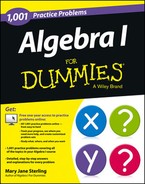Chapter 17
Making Inequalities More Fair
An inequality is a statement involving more than one expression and/or number. When two expressions are set greater than or less than one another, you want to determine for what numbers the statement is true. Inequalities can also involve several statements, one greater than the next, greater than the next, and so on. Solving these statements involves treating each section exactly the same and using the rules for dealing with inequalities.
The Problems You'll Work On
In short, here's what you'll be doing in this chapter:
What to Watch Out For
As you zip through the problems in this chapter, keep the following in mind:
Performing Operations on Inequalities
716–719 Perform the indicated operation on the inequalities.
716. Starting with 7 > 3, add −2 to each side, and then multiply each side by −4.
717. Starting with −4 < 1, multiply each side by −2, and then subtract 3 from each side.
718. Starting with −6 ≤ 6, divide each side by −3, and then add 3 to each side of the equation.
719. Starting with 0 ≥ −4, add 3 to each side of the equation and then multiply each side by −1.
Writing Inequalities Using Interval Notation
720–723 Change the inequality notation to interval notation.
720. −3 ≤ x < 2
721. 0 ≤ x ≤ 4
722. x > −3
723. x ≤ 7
Changing Interval Notation to Inequality Notation
724–727 Change the interval notation to inequality notation.
724. [−6, ∞)
725. (−∞, −2)
727. (2, 3)
Solving Linear Inequalities
728–733 Solve each linear inequality for the values of the variable.
728. 2x − 5 < 3
729. 3x − 2 ≥ 4x + 3
730. −3(x + 7) ≤ 2x + 9
731. ![]()
732. ![]()
733. ![]()
Taking on Compound Inequalities
734–737 Solve each compound inequality
734. −5 ≤ 3x + 1 < 7
735. −4 < 6 − 5x < 11
736. ![]()
737. −15 < −3(3 − 2x) < −9
Solving Quadratic Inequalities
738–745 Solve each quadratic inequality using a number line.
738. (x − 3)(x + 4) < 0
739. (2x + 5)(x + 8) ≥ 0
740. x2 − 8x − 9 ≤ 0
742. 48 − x2 > −2x
743. 36 − x2 ≤ 0
744. 5x2 < 15x
745. x2 + 4x + 4 ≥ 0
Finding Solutions of Nonlinear Inequalities
746–753 Solve each nonlinear inequality using a number line.
746. x(x + 3)(x − 2) > 0
747. (x + 1)2(x + 5)(x − 7) ≤ 0
748. x3 + x2 − 36x − 36 ≥ 0
749. x3 − 2x2 + x < 0
750. ![]()
751. ![]()
752. ![]()
753. ![]()
Rewriting and Solving Absolute Value Inequalities
754–761 Solve the absolute value inequalities by rewriting the statements.
754. |3x + 2| ≥ 7
755. |4 − x| < 6
757. ![]()
758. |x + 4| − 5 > 3
759. |5 − 2x| + 4 ≤ 7
760. 2|x − 5| − 4 ≥ −2
761. ![]()
Delving into Complex Inequalities
762–765 Solve the complex inequalities.
762. −4 < 3x + 2 ≤ 2x + 3
763. ![]()
764. −5 < 4x − 1 < 6x + 7
765. x + 1 ≤ 3x + 5 < 8
